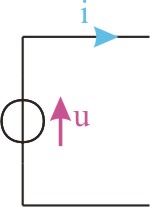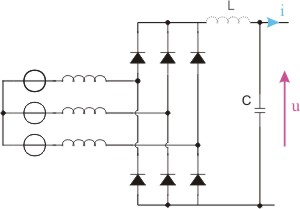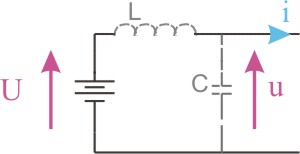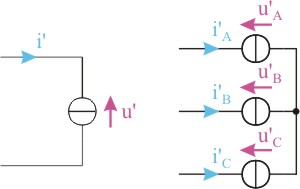The autonomous inverters are converters used to supply AC loads starting from a DC source.
They are, generally, mono-phased and tri-phased.
Depending on the applications, they can:
- supply one or more fixed amplitude and frequency alternative voltages: it is the case of the security sources that substitute the grid in the case of its fault.
- supply alternative voltages or currents having variable frequency and amplitude: it is the case of the inverters supplying the AC motors (synchronous or asynchronous) that must turn with variable speed.
There are two important types of autonomous inverters:
The voltage source inverters
A voltage source inverter is supplied from a DC generator having voltage source character.
- Ideally, the input voltage has a constant value U, independent of the current i absorbed by the inverter (figure 1).

Figure 1
- In practice, the "voltage source" character of the generator is obtained by connecting in parallel with its terminals a high capacity capacitor C, or a L-C filter. The generator itself is most often
- the rectified grid (figure 2)

Figure 2
- a battery of accumulators (figure 3)

Figure 3
In order to accomplish the rule of the sources' alternation, the inverter must supply an AC load having
current source character.
- Ideally, the current absorbed by the load is (figure 4)

Figure 4
- a sinusoidal current, if the load is mono-phased
- a symmetrical tri-phased system of sinusoidal currents, if the load is tri-phased.
- In practice, the current source character of the load comes from the series inductances present at its terminals (figure 5).

Figure 5
In the bridge inverters, each terminal of the load is connected to the source by two semiconductor switches: one allows the connection to the + terminal of the generator, the other to the - terminal. These two switches form an inverter arm (figure 6).
By controlling the state (ON-OFF, conducting - blocking) of the switches, the voltages across the load terminals can be imposed in such way to obtain one or more alternative voltages.
The current or the currents absorbed by the load depend on the applied voltages. These currents and the command of the switches determine the current absorbed from the generator.
For studying the voltage source inverters, it is firstly important to fix the structure, by establishing the necessary characteristics of the semiconductor switches and the way they switch from one state to another.
Then, different types of command will be examined

The current inverters



